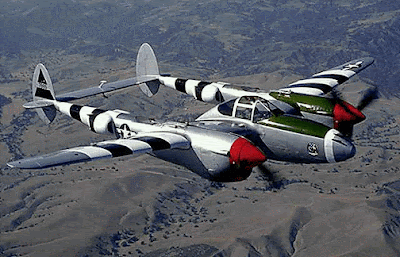Thursday, October 20, 2011
P-38 Lightning
The Lockheed P-38 Lightning was a World War II American fighter aircraft built by Lockheed. Developed to a United States Army Air Corps requirement, the P-38 had distinctive twin booms and a single, central nacelle containing the cockpit and armament. Named "fork-tailed devil" by the Luftwaffe and "two planes, one pilot" by the Japanese, the P-38 was used in a number of roles, including dive bombing, level bombing, ground-attack, photo reconnaissance missions,[5] and extensively as a long-range escort fighter when equipped with drop tanks under its wings.
P 51 Mustang
The North American Aviation P-51 Mustang was an American long-range, single-seat fighter and fighter-bomber used during World War II, the Korean War and in several other conflicts. During World War II Mustang pilots claimed 4,950 enemy aircraft shot down, the most of any Allied fighter.
Focke Wulf Fw 190
The Focke-Wulf Fw 190 Würger (Shrike) was a German Second World War single-seat, single-engine fighter aircraft designed by Kurt Tank in the late 1930s. Powered by a radial engine, the 190 had ample power and was able to lift larger loads than its well-known counterpart, the Messerschmitt Bf 109. The 190 was used by the Luftwaffe in a wide variety of roles, including day fighter, fighter-bomber, ground-attack aircraft and, to a lesser degree, night fighter.
B17 Flying Fortress
The Boeing B-17 Flying Fortress is a four-engine heavy bomber aircraft developed in the 1930s for the then-United States Army Air Corps (USAAC). Competing against Douglas and Martin for a contract to build 200 bombers, the Boeing entry outperformed both competitors and more than met the Air Corps' expectations. Although Boeing lost the contract because the prototype crashed, the Air Corps was so impressed with Boeing's design that they ordered 13 more B-17s for further evaluation. From its introduction in 1938, the B-17 Flying Fortress evolved through numerous design advances.
Saturday, October 15, 2011
Harrier II
The British Aerospace/McDonnell Douglas Harrier II is a second-generation vertical/short takeoff and landing (V/STOL) jet aircraft used previously by the Royal Air Force (RAF) and, between 2006–2010, the Royal Navy. Derived from the McDonnell Douglas AV-8B Harrier II, which was a development of the Hawker Siddeley Harrier, the BAe Harrier II was produced as the Harrier GR5/GR7/GR9. Both are primarily used for light attack or multi-role tasks, and are often operated from small aircraft carriers. The Harrier II fell victim to a UK defence review which saw all its operational airframes retired from service in December 2010.
Saab 37 Viggen
The Saab 37 Viggen (English: Thunderbolt) was a Swedish single-seat, single-engine, short-medium range fighter and attack aircraft, manufactured between 1970 and 1990. Several variants were produced to perform the roles of all-weather fighter-interceptor, ground-attack and photo-reconnaissance, as well as a two-seat trainer.
Eurofighter 69 -Typhoon
The Eurofighter Typhoon is a twin-engine, canard-delta wing, multirole combat aircraft, designed and built by a consortium of three companies: EADS, Alenia Aeronautica and BAE Systems; working through a holding company, Eurofighter GmbH, which was formed in 1986. The project is managed by the NATO Eurofighter and Tornado Management Agency, which acts as the prime customer.[5]
Monday, October 3, 2011
B-2 Spirit
Northrop Grumman B-2 Spirit
The Northrop Grumman B-2 Spirit (also known as the Stealth Bomber) is an American heavy bomber with low observable stealth technology designed to penetrate dense anti-aircraft defenses and deploy both conventional and nuclear weapons. The bomber has a crew of two and can drop up to 80 500 lb (230 kg)-class JDAM GPS-guided bombs, or 16 2,400 lb (1,100 kg) B83 nuclear bombs. The B-2 is the only aircraft that can carry large air to surface standoff weapons in a stealth configuration. / B2 Spirit.
Subscribe to:
Posts (Atom)

















































